Dynamic Shear Modulus and Damping Ratio of Sand–Rubber Mixtures under Large Strain Range
Abstract
1. Introduction
2. Materials and Experimental Methods
2.1. Raw Materials
2.2. Sample Preparation and Mixture Designs
2.3. Test Equipment and Process
3. Constitutive Relation and Parameters
4. Dynamic Cyclic Triaxial Test Results
4.1. Dynamic Shear Stress–Strain Relationship
4.2. Dynamic Shear Modulus
4.3. Damping Ratio
5. Discussion of Experimental Results
- An increase in the rubber volume content causes some sand particles in the specimens to be replaced by rubber particles, increasing the weak contacts between rubber and sand, in turn decreasing the intergranular friction and leading to a decrease in the damping ratio. At a sufficiently high rubber volume content, the development of more weak contact points is expected to cause the specimens to behave more linearly, leading to a damping ratio that is less sensitive to the variation in the shear strain amplitude. Liu et al. [11] reported that rubber particle begin to consistently contact each other at a medium rubber volume content (20–40%). With increasing incidence of sand–rubber–sand and rubber–rubber force transmission chains, the overall stiffness of the sand–rubber mixture specimens are further decreased and deformability increased due to the elasticity of the more prevalent rubber particles. This explains why the mixtures with rubber volume contents of approximately 20–30% exhibit damping performance superior to that of pure sand in this study.
- Although the results of Liu et al. [11] illustrate different force transmission chains according to rubber volume content, we determined in this study that the quantities and types of force transmission chains are also influenced by the particle size. As can be seen in Figure 15, when the rubber volume content is kept constant, smaller rubber particles more effectively fill the gaps between sand particles. In other words, the quantity of sand–rubber and rubber–rubber contact points increase, increasing the number of rubber–rubber and sand–rubber–sand force transmission chains, and facilitating the movement of sand particles during shear loading, ultimately leading to higher damping ratio. This finding is compatible with the numerical modelling results obtained by Lopera Perez et al. [33], and demonstrates that rubber volume content and particle size comprehensively affect the damping ratio of a rubber–sand mixture. Accordingly, as the mean rubber particle sizes of SRP2 and SRP1 are smaller than that of pure sand in this study, the damping ratios of these mixture specimens are similar.
- In pure sand, intergranular friction increases with increasing confining pressure. This mechanism reduces the relative movement between sand particles and subsequently decreases the width of the hysteresis loop, which is a recognized event in geotechnical earthquake engineering literature [31]. However, the flexibility of the added rubber particles facilitates the rearrangement and relative movement of the sand particles, which are influenced by the shear strain level [7]. Hence, there exists a critical shear strain controlling the damping behavior of sand–rubber mixtures that depends on the applied confining pressure. The existence of such a critical strain in this study is compatible with the results of Senetakis et al. [21], which were solely based on experimental data within a shear strain range of 10−3% to 5 × 10−2%; behavior beyond this range was predicted by curve fitting assuming a hyperbolic model. In this study, tests were conducted over a much wider shear strain range.
6. Empirical Model
6.1. Maximum Shear Modulus
6.2. Empirical Model and Validation
6.3. Reference Shear Strain and Normalized Shear Modulus
7. Summary and Conclusions
- Almost all samples exhibited strain-hardening behavior, that is, the maximum dynamic shear stress was observed at large strains. The stress–strain relationship under cyclic loading exhibited hysteresis, non-linearity, and strain accumulation. As the rubber volume content of the mixture specimens increased, the stress–strain curve shifted upward, whereas the results were the opposite as the confining pressure increased. The rubber particle size was also observed to affect the relationship between stress and strain.
- As the rubber volume content increased, the shear moduli of all mixture specimens first decreased significantly but then slowly and finally tended to stability with ongoing increase in strain. However, increasing confining pressure and rubber particle size led to an increase in the shear modulus. This can be attributed to the number of sand–rubber and rubber–rubber contact points increasing with increasing rubber volume content, consequently decreasing the shear moduli of the mixture specimens.
- The performance of the mixture specimen damping ratios was observed to be complicated. At shear strain amplitudes less than a critical strain value, the damping ratios of the mixture specimens increased with increasing rubber volume content and showed a higher damping ratio than pure sand. However, at shear strains higher than a critical strain value, the opposite trend was observed. In addition, the damping ratio decreased slightly with increasing confining pressure, and considerably increased with decreasing rubber particle size.
- The maximum shear modulus was observed to decrease with increasing rubber volume content. The relationship between the maximum shear modulus and rubber volume content was found to be linear, while that between the maximum shear modulus and confining pressure was found to be exponential. An empirical model was, accordingly, proposed for the maximum shear modulus and verified against the experimental results. The verified empirical model was then used to calculate the reference shear strain and normalized shear modulus according to rubber volume content, rubber particle size, and confining pressure, as the attenuation of the shear modulus is critical to the accurate representation of the dynamic behavior of sand–rubber mixtures. It was found that when the confining pressure and rubber particle size were held constant, a higher rubber volume content resulted in higher normalized shear modulus (Gd/Gdmax) values. Furthermore, the normalized shear modulus values calculated using the experimental results were found to match the values predicted using the proposed empirical model. Thus, the proposed empirical model can serve as a reference for estimating the maximum shear modulus of a sand–rubber mixture.
Author Contributions
Funding
Conflicts of Interest
References
- Brunet, S.; de la Llera, J.C.; Kausel, E. Non-linear modeling of seismic isolation systems made of recycled tire-rubber. Soil. Dyn. Earthq. Eng. 2016, 85, 134–145. [Google Scholar] [CrossRef]
- Yoon, Y.W.; Heo, S.B.; Kim, K.S. Geotechnical performance of waste tires for soil reinforcement from chamber tests. Geotext. Geomembr. 2008, 26, 100–107. [Google Scholar] [CrossRef]
- Liu, H.; Wang, X.; Jiao, Y.; Sha, T. Experimental investigation of the mechanical and durability properties of crumb rubber concrete. Materials 2016, 9, 172. [Google Scholar] [CrossRef]
- Xiao, M.; Ledezma, M.; Hartman, C. Shear resistance of tire-derived aggregate using large-scale direct shear tests. J. Mater. Civ. Eng. 2015, 27, 04014110. [Google Scholar] [CrossRef]
- Hennebert, P.; Lambert, S.; Fouillen, F.; Charrasse, B. Assessing the environmental impact of shredded tires as embankment fill material. Can. Geotech. J. 2014, 51, 469–478. [Google Scholar] [CrossRef]
- O’Shaughnessy, V.; Garga, V.K. Tire-reinforced earthfill. Part 3: Environmental assessment. Can. Geotech. J. 2000, 37, 117–131. [Google Scholar] [CrossRef]
- Sarajpoor, S.; Kavand, A.; Zogh, P.; Ghalandarzadeh, A. Dynamic behavior of sand-rubber mixtures based on hollow cylinder tests. Constr. Build. Mater. 2020, 251, 118948. [Google Scholar] [CrossRef]
- Xie, T.; Wang, F.; Xie, C.; Lei, S.; Yu, S.; Liu, J.; Huang, D. Mechanical Properties of Natural Rubber Filled with Foundry Waste Derived Fillers. Materials 2019, 12, 1863. [Google Scholar] [CrossRef]
- Petrella, A.; Di Mundo, R.; De Gisi, S.; Todaro, F.; Labianca, C.; Notarnicola, M. Environmentally sustainable cement composites based on end-of-life tyre rubber and recycled waste porous glass. Materials 2019, 12, 3289. [Google Scholar] [CrossRef]
- Lee, C.; Truong, Q.H.; Lee, W.; Lee, J.S. Characteristics of rubber-sand particle mixtures according to size ratio. J. Mater. Civ. Eng. 2010, 22, 323–331. [Google Scholar] [CrossRef]
- Liu, L.; Cai, G.; Liu, S. Compression properties and micro-mechanisms of rubber-sand particle mixtures considering grain breakage. Constr. Build. Mater. 2018, 187, 1061–1072. [Google Scholar] [CrossRef]
- Li, H.; Jiang, H.; Zhang, W.; Liu, P.; Wang, S.; Wang, F.; Zhang, J.; Yao, Z. Laboratory and field investigation of the feasibility of crumb rubber waste application to improve the flexibility of anti-rutting performance of asphalt pavement. Materials 2018, 11, 1738. [Google Scholar] [CrossRef]
- Edil, T.B.; Bosscher, P.J. Engineering properties of tire chips and soil mixtures. Geotech. Test. J. 1994, 17, 453–464. [Google Scholar]
- Yu, S.M.; Shan, Y. Experimental Comparison and Study on Small-Strain Damping of Remolded Saturated Soft Clay. Geotech. Geol. Eng. 2017, 35, 2479–2483. [Google Scholar] [CrossRef]
- Masad, E.; Taha, R.; Ho, C.; Papagiannakis, T. Engineering properties of tire/soil mixtures as a lightweight fill material. Geotech. Test. J. 1996, 19, 297–304. [Google Scholar]
- Li, L.H.; Chen, Y.J.; Ferreira, P.M.V.; Liu, Y.; Xiao, H.-L. Experimental investigations on the pull-out behavior of tire strips reinforced sands. Materials 2017, 10, 707. [Google Scholar]
- Naderi, K.; Asgharzadeh, S.M.; Tabatabaee, N.; Partl, M.N. Evaluating Aging Properties of Crumb Rubber and Styrene–Butadiene–Styrene Modified Binders. Transp. Res. Rec. 2014, 2444, 110–119. [Google Scholar] [CrossRef]
- Yadav, J.S.; Tiwari, S.K. The impact of end-of-life tires on the mechanical properties of fine-grained soil: A Review. Environ. Dev. Sustain. 2017, 21, 485–568. [Google Scholar] [CrossRef]
- Lo Presti, D. Recycled Tyre Rubber Modified Bitumens for road asphalt mixtures: A literature review. Constr. Build. Mater. 2013, 49, 863–881. [Google Scholar] [CrossRef]
- Kaewunruen, S.; Li, D.; Chen, Y.; Xiang, Z. Enhancement of dynamic damping in eco-friendly railway concrete sleepers using waste-tyre crumb rubber. Materials 2018, 11, 1169. [Google Scholar] [CrossRef]
- Senetakis, K.; Anastasiadis, A.; Pitilakis, K. Dynamic properties of dry sand/rubber (SRM) and gravel/rubber (GRM) mixtures in a wide range of shearing strain amplitudes. Soil Dyn. Earthq. Eng. 2012, 33, 38–53. [Google Scholar] [CrossRef]
- Li, D.; Liu, X.; Liu, X. Experimental study on artificial cemented sand prepared with ordinary Portland cement with different contents. Materials 2015, 8, 3960–3974. [Google Scholar] [CrossRef] [PubMed]
- Senetakis, K.; Anastasiadis, A. Effects of state of test sample, specimen geometry and sample preparation on dynamic properties of rubber–sand mixtures. Geosynth. Int. 2015, 22, 301–310. [Google Scholar] [CrossRef]
- Shan, Y.; Chen, J.; Ke, X.; Mo, H. Resonant Column Test Study of the Effect of Clay Minerals on Maximum Dynamic Shear Modulus in Marine Clay. In Proceedings of the 7th International Conference on Earthquake Geotechnical Engineering, Roma, Italy, 17–20 June 2019; CRC Press: Boca Raton, FL, USA, 2019. [Google Scholar]
- Mavronicola, E.; Komodromos, P.I.; Charmpis, D.C. Numerical investigation of potential usage of rubber-soil mixtures as a distributed seismic isolation approach. Civ. Comp. Proc. 2010, 93. [Google Scholar] [CrossRef]
- Tsang, H.H. Seismic isolation by rubber–soil mixtures for developing countries. Earthq. Eng. Struct. Dyn. 2008, 37, 283–303. [Google Scholar] [CrossRef]
- Hazarika, H.; Yasuhara, K.; Karmokar, A.; Mitarai, Y. Shaking table test on liquefaction prevention using tire chips and sand mixture. In Proceedings of the International Workshop on Scrap Tire Derived Geomaterials—Opportunities and Challenges, Yokosuka, Japan, 23–24 March 2007; pp. 215–222. [Google Scholar]
- Pistolas, A.; Anastasiadis, A.; Pitilakis, K. Dynamic modulus and damping of gravel-recycled rubber mixtures: Resonant column and cyclic triaxial tests. In Proceedings of the XVI ECSMGE 2015, Edinburgh, UK, 13–17 September 2015; pp. 2613–2618. [Google Scholar]
- Okur, D.V.; Umu, S.U. Dynamic Properties of Clean Sand Modified with Granulated Rubber. Adv. Civ. Eng. 2018, 2018, 1–11. [Google Scholar] [CrossRef]
- Madhusudhan, B.R.; Boominathan, A.; Banerjee, S. Static and Large-Strain Dynamic Properties of Sand–Rubber Tire Shred Mixtures. J. Mater. Civ. Eng. 2017, 29, 04017165. [Google Scholar] [CrossRef]
- Nakhaei, A.; Marandi, S.M.; Sani Kermani, S.; Bagheripour, M.H. Dynamic properties of granular soils mixed with granulated rubber. Soil Dyn. Earthq. Eng. 2012, 43, 124–132. [Google Scholar] [CrossRef]
- Youwai, S.; Bergado, D.T. Strength and deformation characteristics of shredded rubber tire sand mixtures. Can. Geotech. J. 2003, 40, 254–264. [Google Scholar] [CrossRef]
- Lopera Perez, J.C.; Kwok, C.Y.; Senetakis, K. Micromechanical analyses of the effect of rubber size and content on sand-rubber mixtures at the critical state. Geotext. Geomembr. 2017, 45, 81–97. [Google Scholar] [CrossRef]
- ASTM International. Standard Practice for Use of Scrap Tires in Civil Engineering Applications; ASTM International: West Conshohocken, PA, USA, 2017. [Google Scholar]
- Tsang, H.H.; Sheikh, M.N.; Lam, N. Rubber-Soil Cushion for Earthquake Protection; The University of Wollongong Faculty of Engineering and Information Sciences: Wollongong, Australia, 2007. [Google Scholar]
- ASTM International. Standard Test Methods for Minimum Index Density and Unit Weight of Soils and Calculation of Relative Density; ASTM International: West Conshohocken, PA, USA, 2016. [Google Scholar]
- ASTM International. Standard Test Methods for the Determination of the Modulus and Damping Properties of Soils Using the Cyclic Triaxial Apparatus; Withdrawn 2020; ASTM International: West Conshohocken, PA, USA, 2011. [Google Scholar]
- Holownia, B. Effect of Poisson’s ratio on bonded rubber blocks. J. Strain Anal. 1972, 7, 236–242. [Google Scholar] [CrossRef]
- Hardin, B.O.; Drnevich, V.P. Shear modulus and damping in soils: Design equations and curves. J. Soil Mech. Found. Div. 1972, 98, 667–692. [Google Scholar]
- Hardin, B.O.; Drnevich, V.P. Shear modulus and damping in soils: Measurement and parameter effects. J. Soil Mech. Found. Div. 1972, 98, 603–624. [Google Scholar]
- Mashiri, M.; Vinod, J.; Sheikh, M.N.; Tsang, H.-H. Shear strength and dilatancy behaviour of sand–tyre chip mixtures. Soils Found. 2015, 55, 517–528. [Google Scholar] [CrossRef]
- Ehsani, M.; Shariatmadari, N.; Mirhosseini, S.M. Shear modulus and damping ratio of sand-granulated rubber mixtures. J. Cent. South Univ. 2015, 22, 3159–3167. [Google Scholar] [CrossRef]
- Wang, X.; Cui, J.; Wu, Y.; Zhu, C.Q.; Wang, X.Z. Mechanical properties of calcareous silts in a hydraulic fill island-reef. Mater. Georesour. Geotechnol. 2020, 1–14. [Google Scholar] [CrossRef]
- Liu, F.C.; Wu, M.T.; Yang, J. Experimental Study on Normalized Stress-Strain Behavior of Geogrid Reinforced Rubber Sand Mixtures. In Proceedings of the GeoShanghai International Conference, Shanghai, China, 27–30 May 2018; Springer: Berlin, Germany, 2018; pp. 307–317. [Google Scholar]
- Lee, C.; Shin, H.; Lee, J.S. Behavior of sand–rubber particle mixtures: Experimental observations and numerical simulations. Int. J. Numer. Anal. Met. 2014, 38, 1651–1663. [Google Scholar] [CrossRef]
- Shan, Y.; Mo, H.H.; Yu, S.M.; Chen, J.S. Analysis of the maximum dynamic shear modulus and particle arrangement properties of saturated soft clay soils. Soil Mech. Found. Eng. 2016, 53, 226–232. [Google Scholar] [CrossRef]
- Feng, Z.Y.; Sutter, K.G. Dynamic properties of granulated rubber/sand mixtures. Geotech. Test. J. 2000, 23, 338–344. [Google Scholar]
- Wu, Y.; Yamamoto, H.; Cui, J.; Cheng, H. Influence of load mode on particle crushing characteristics of silica sand at high stresses. Int. J. Geomech. 2020, 20, 04019194. [Google Scholar] [CrossRef]

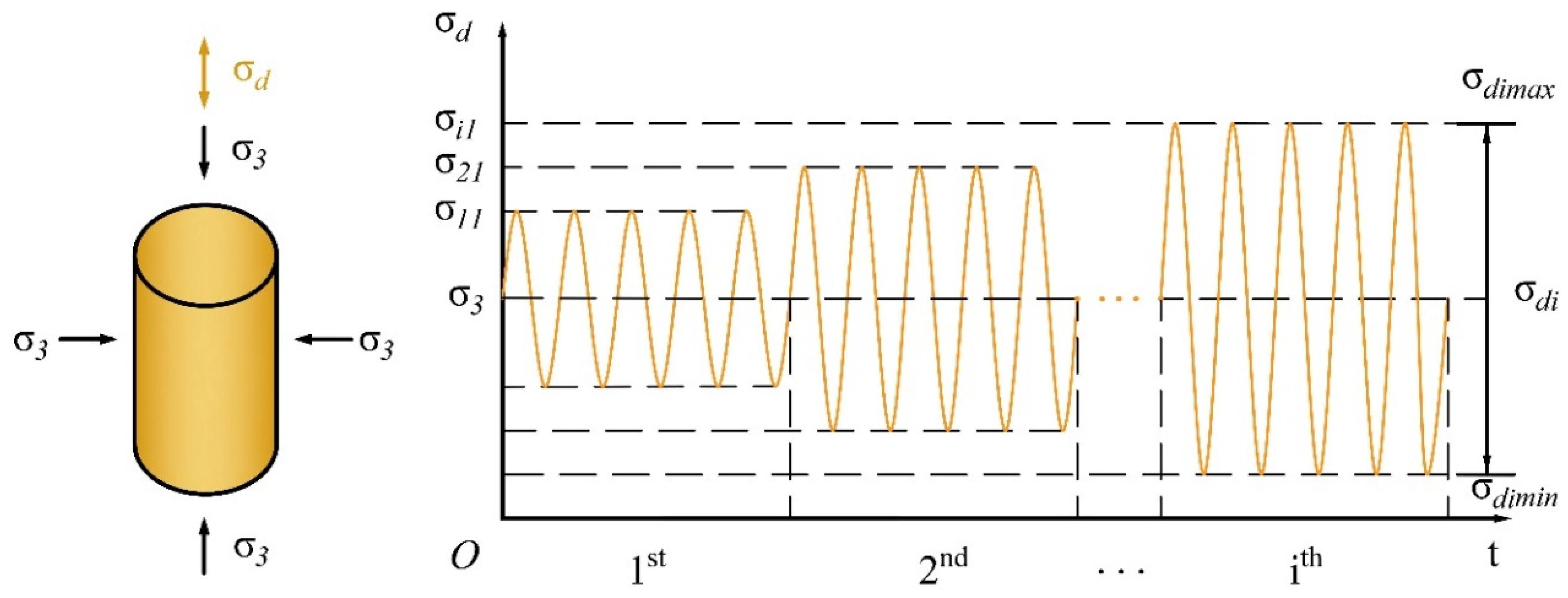
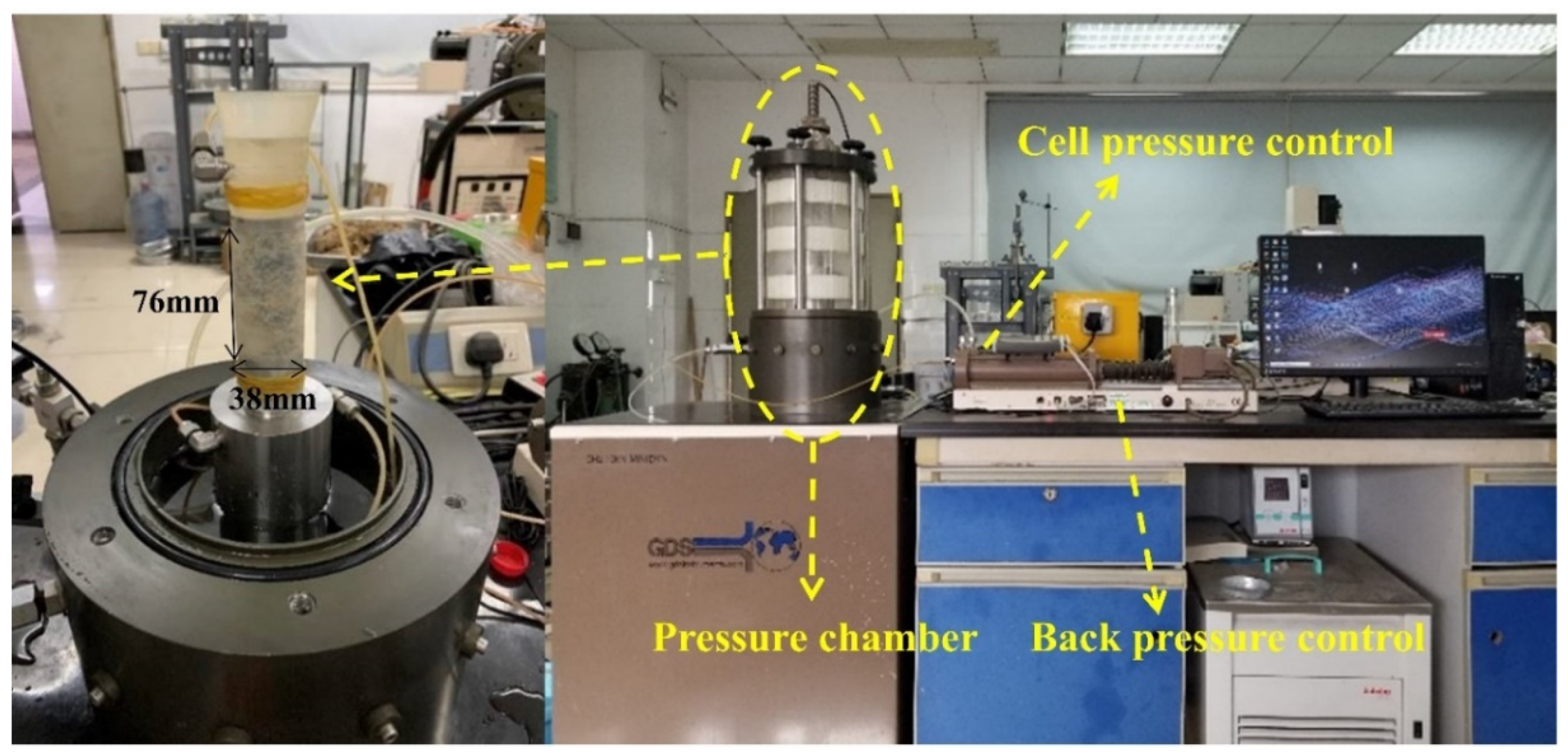
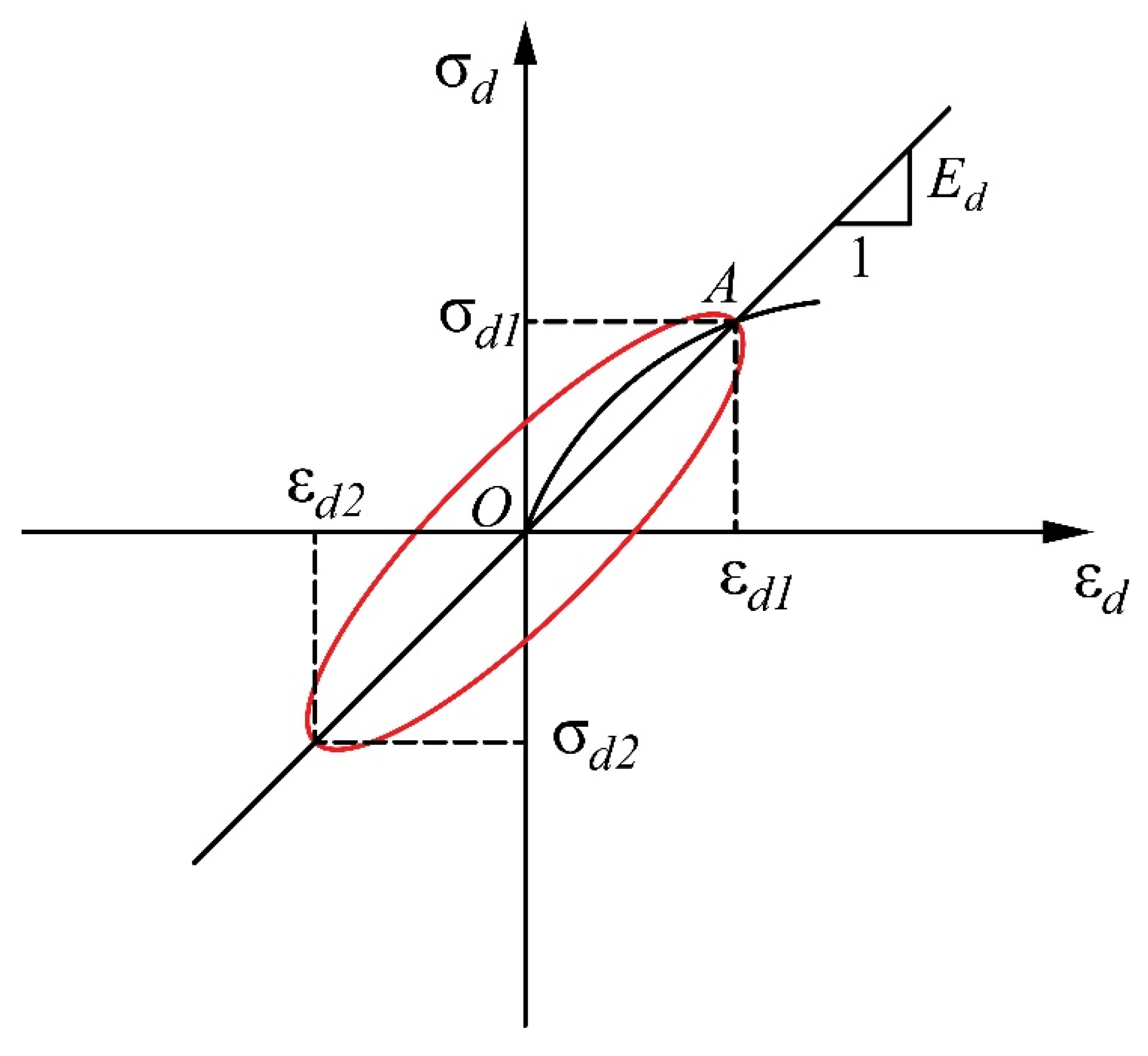
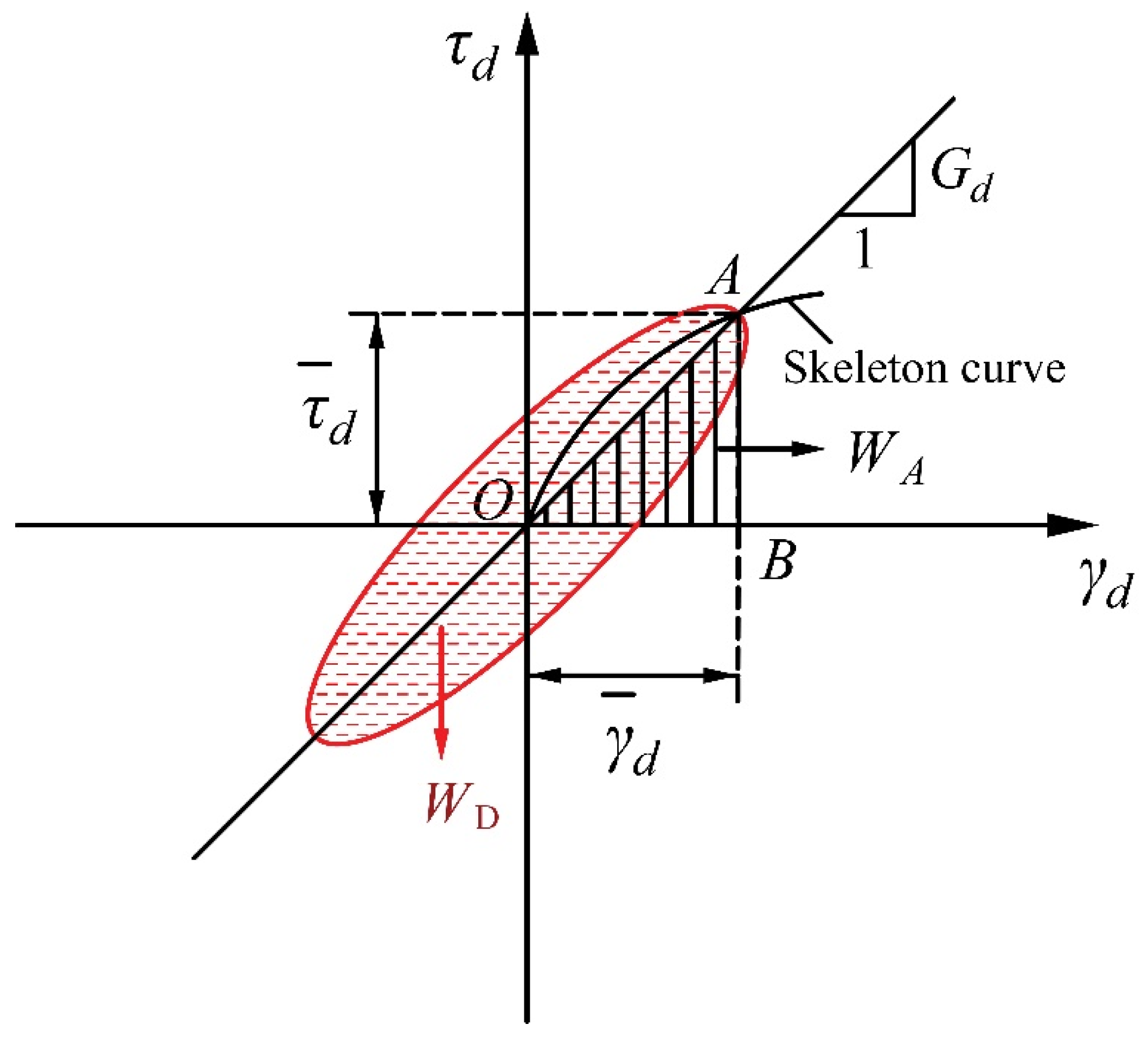


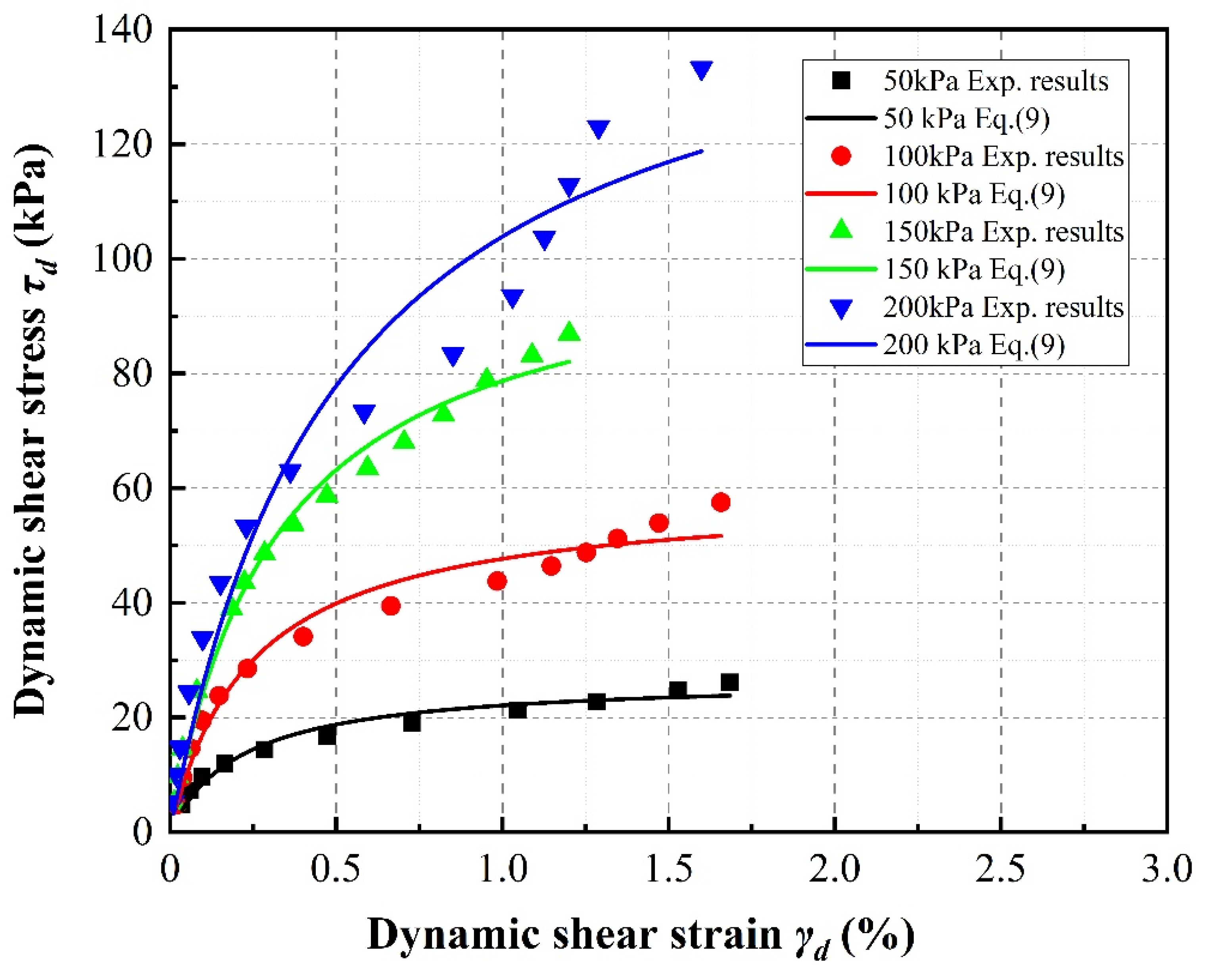
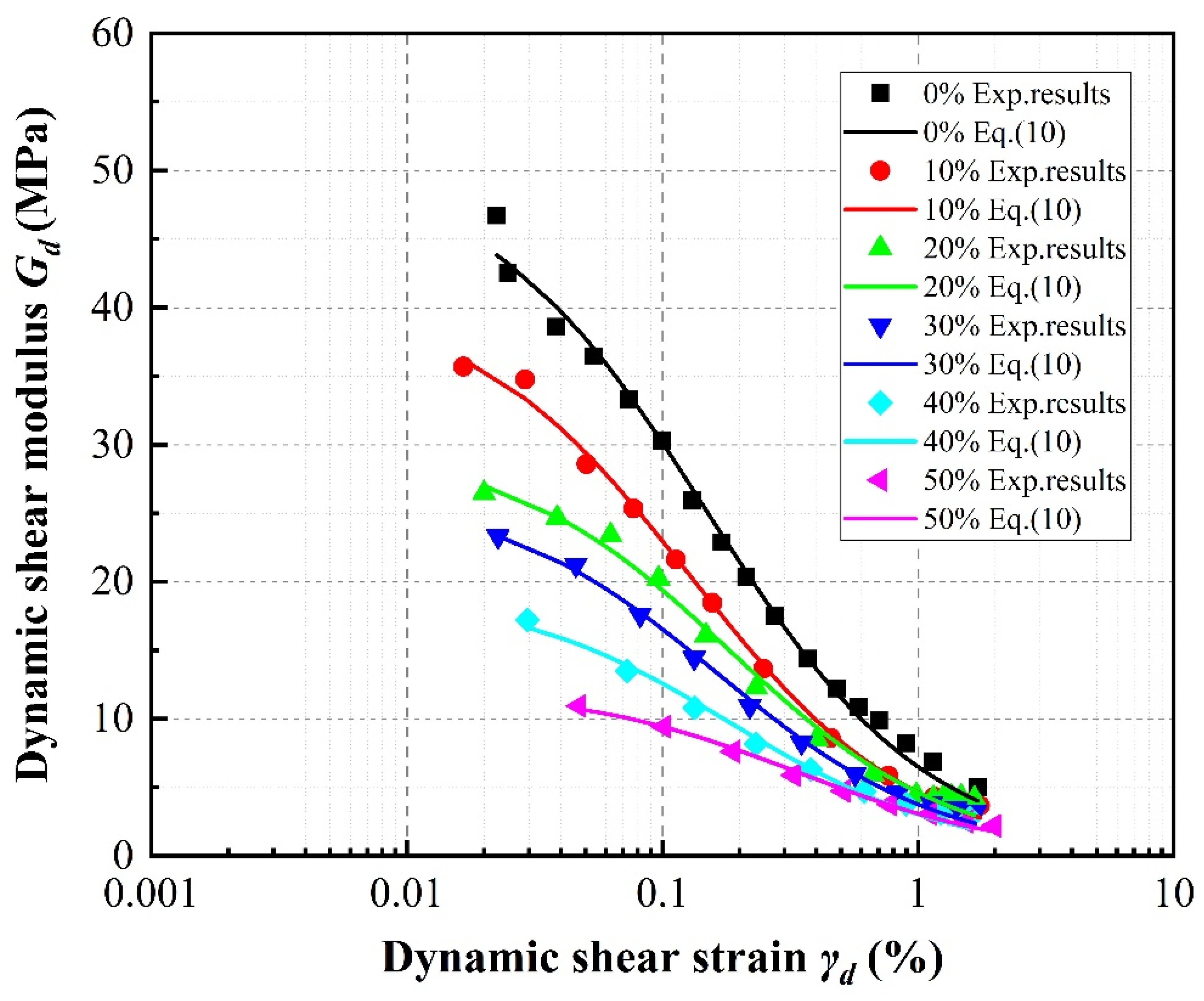
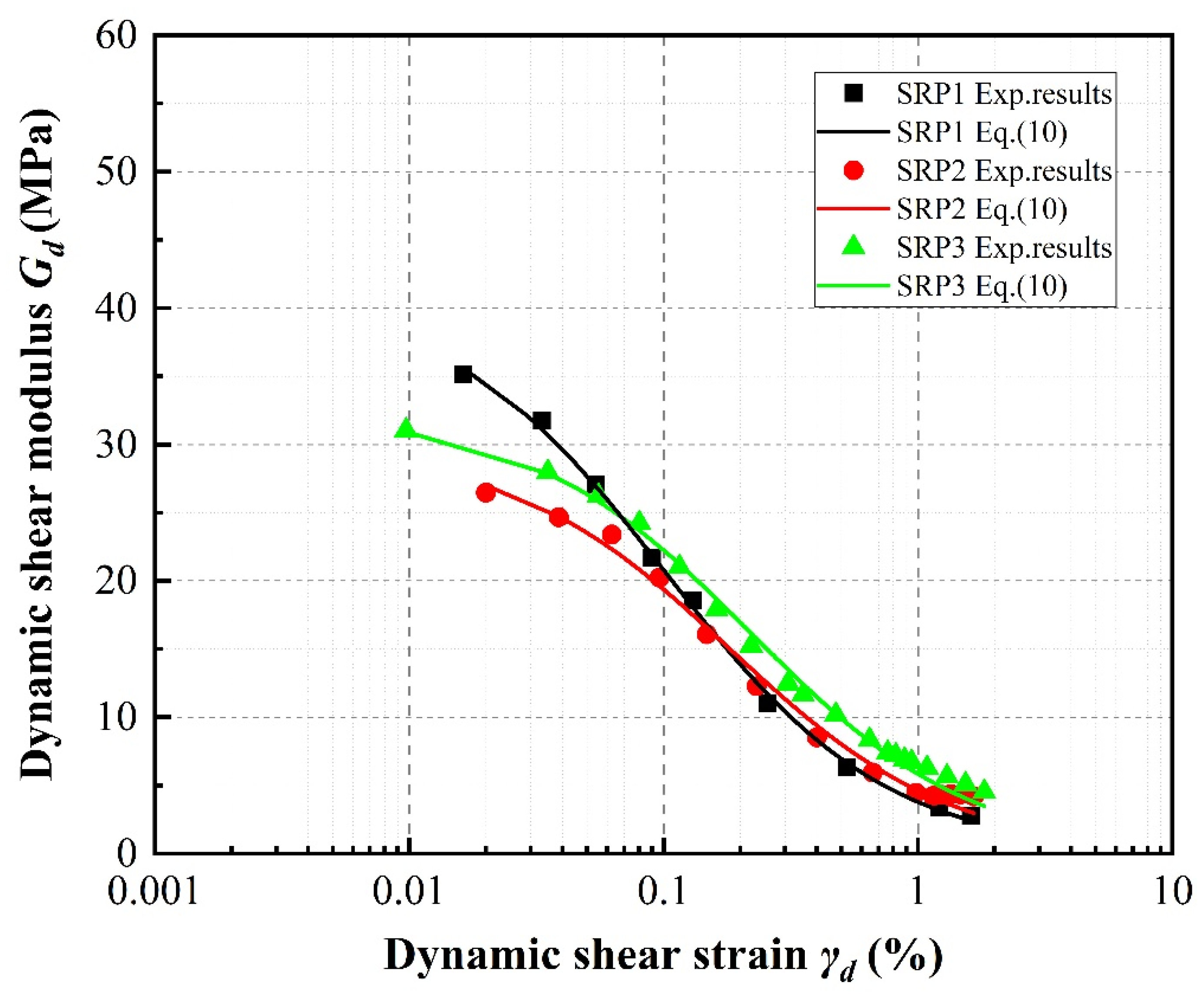
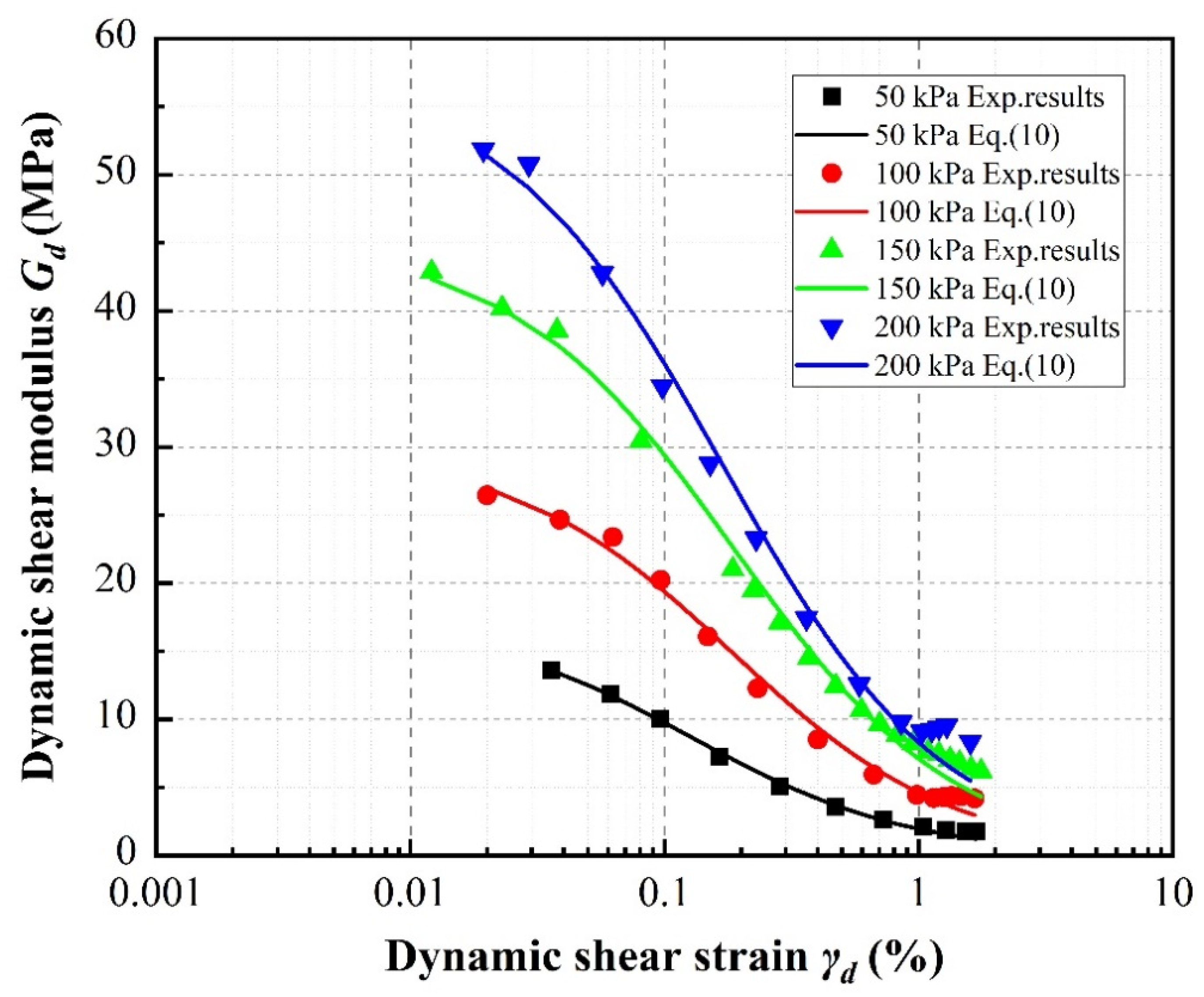
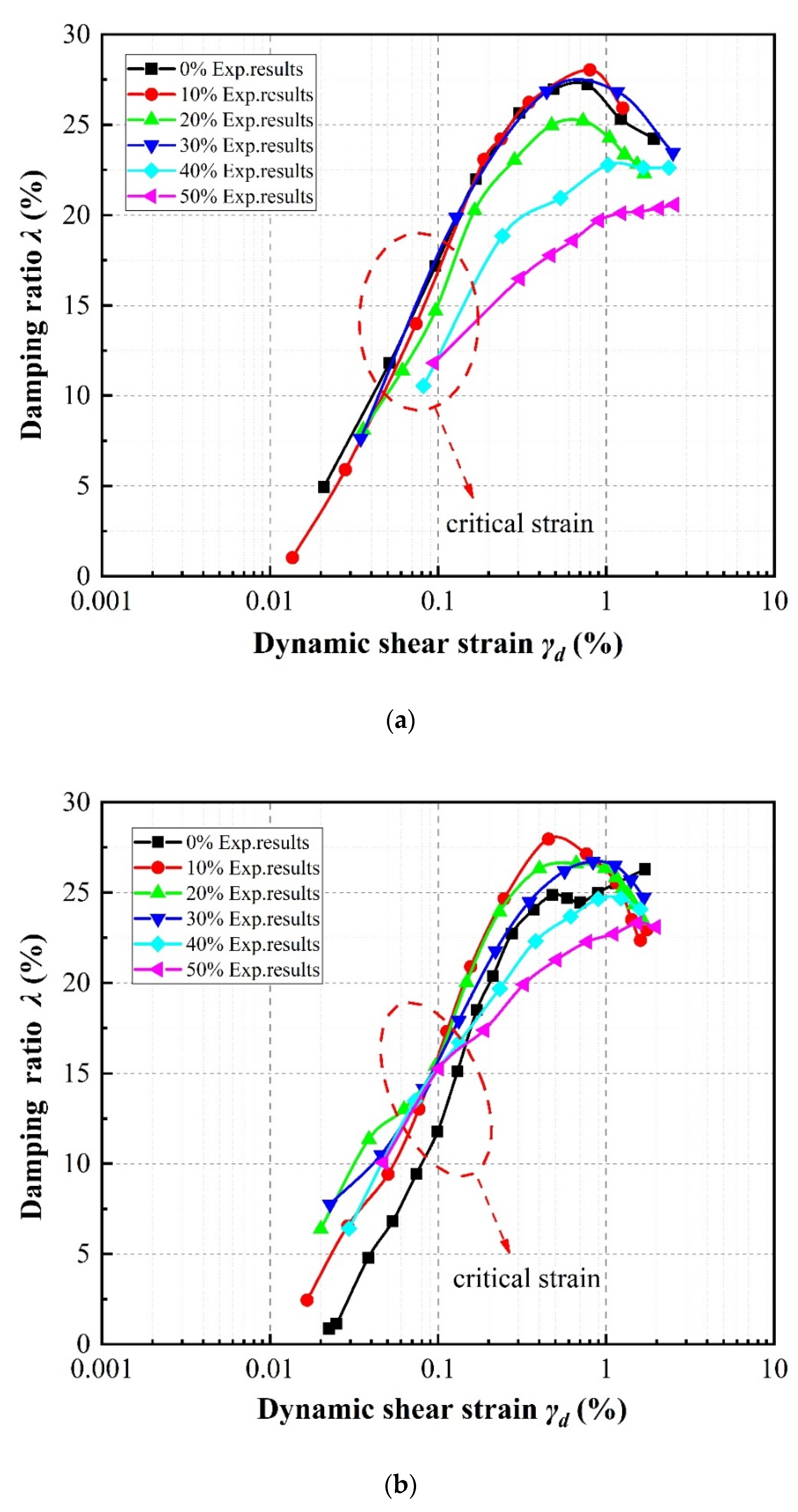
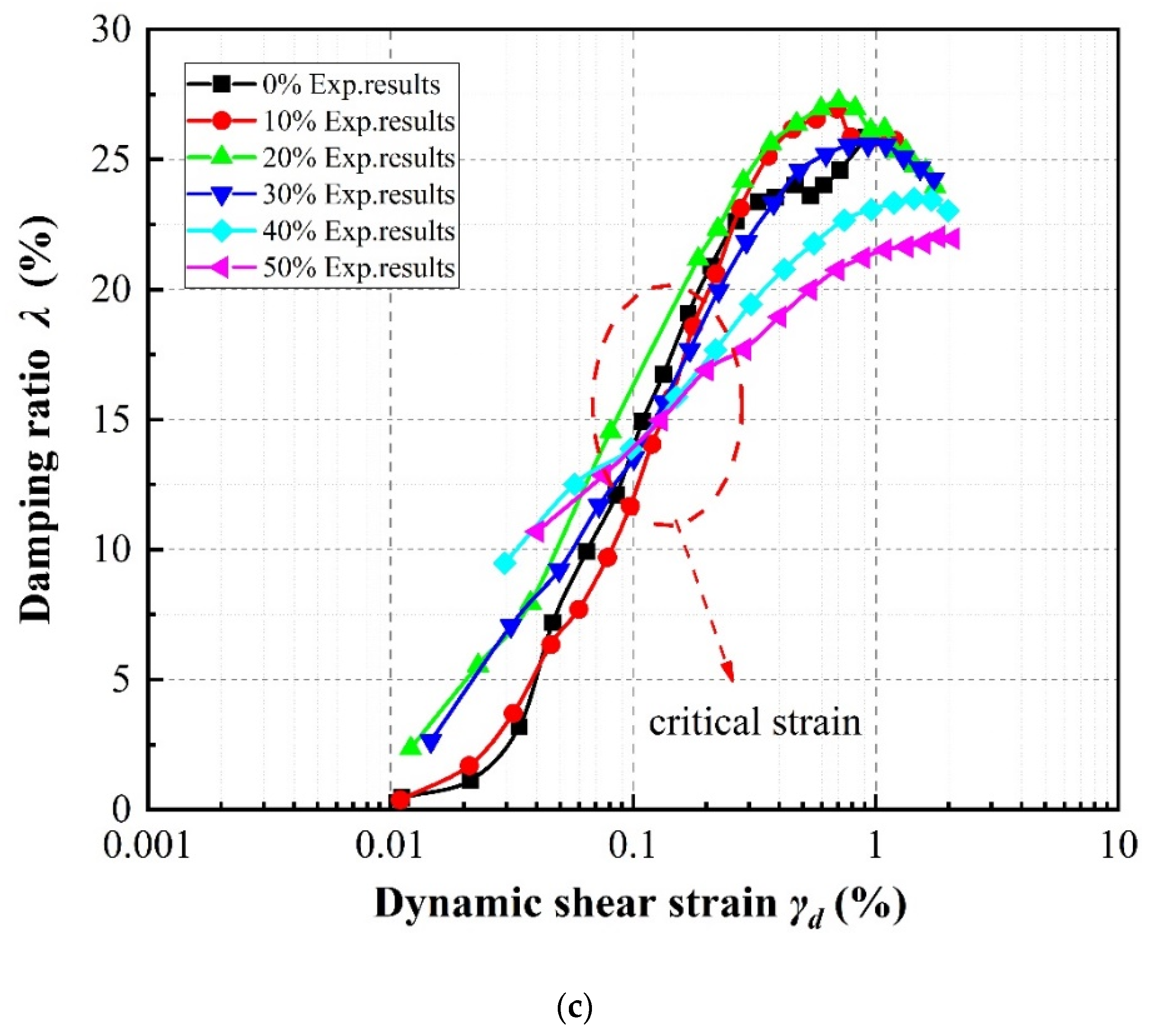
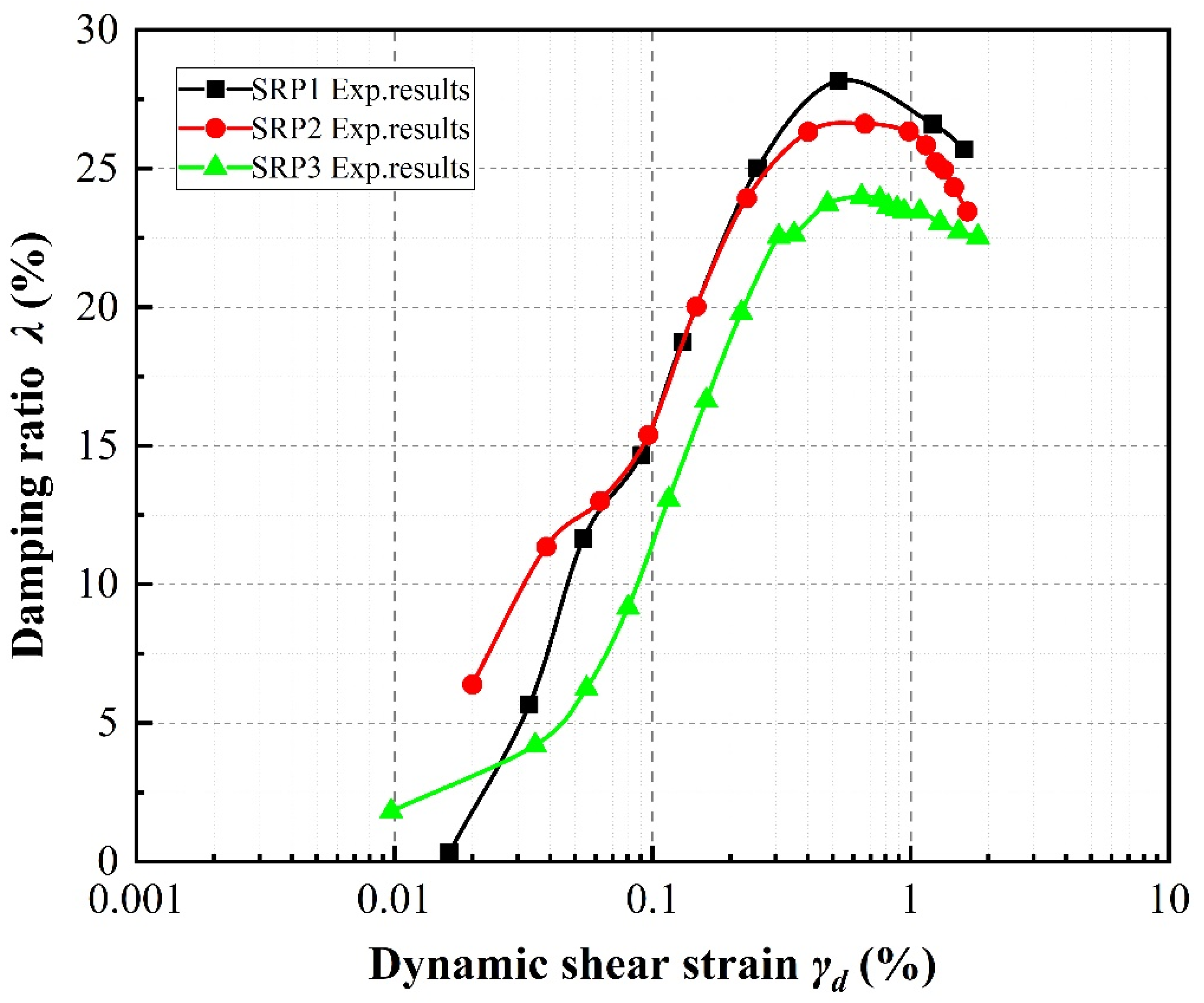
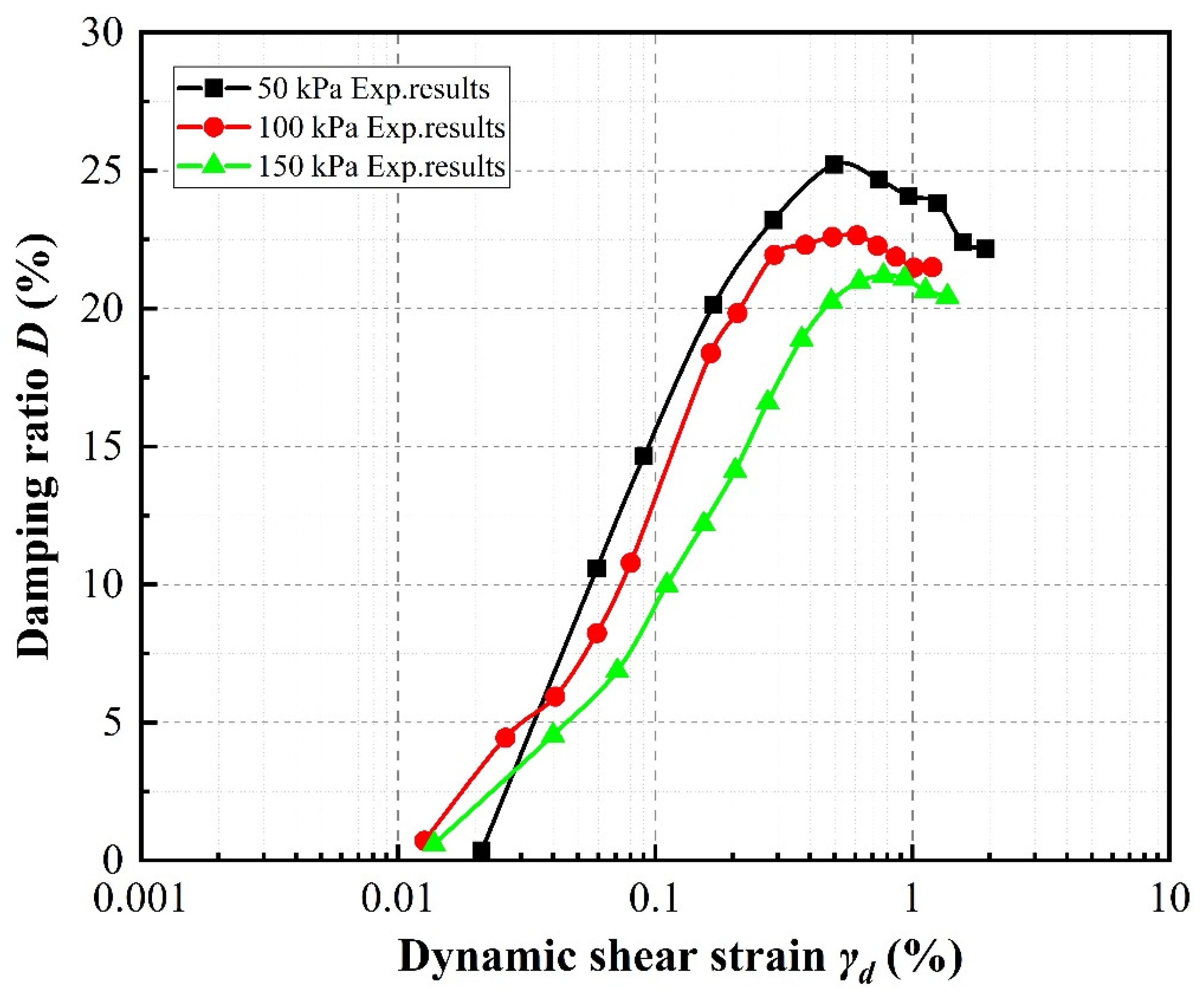
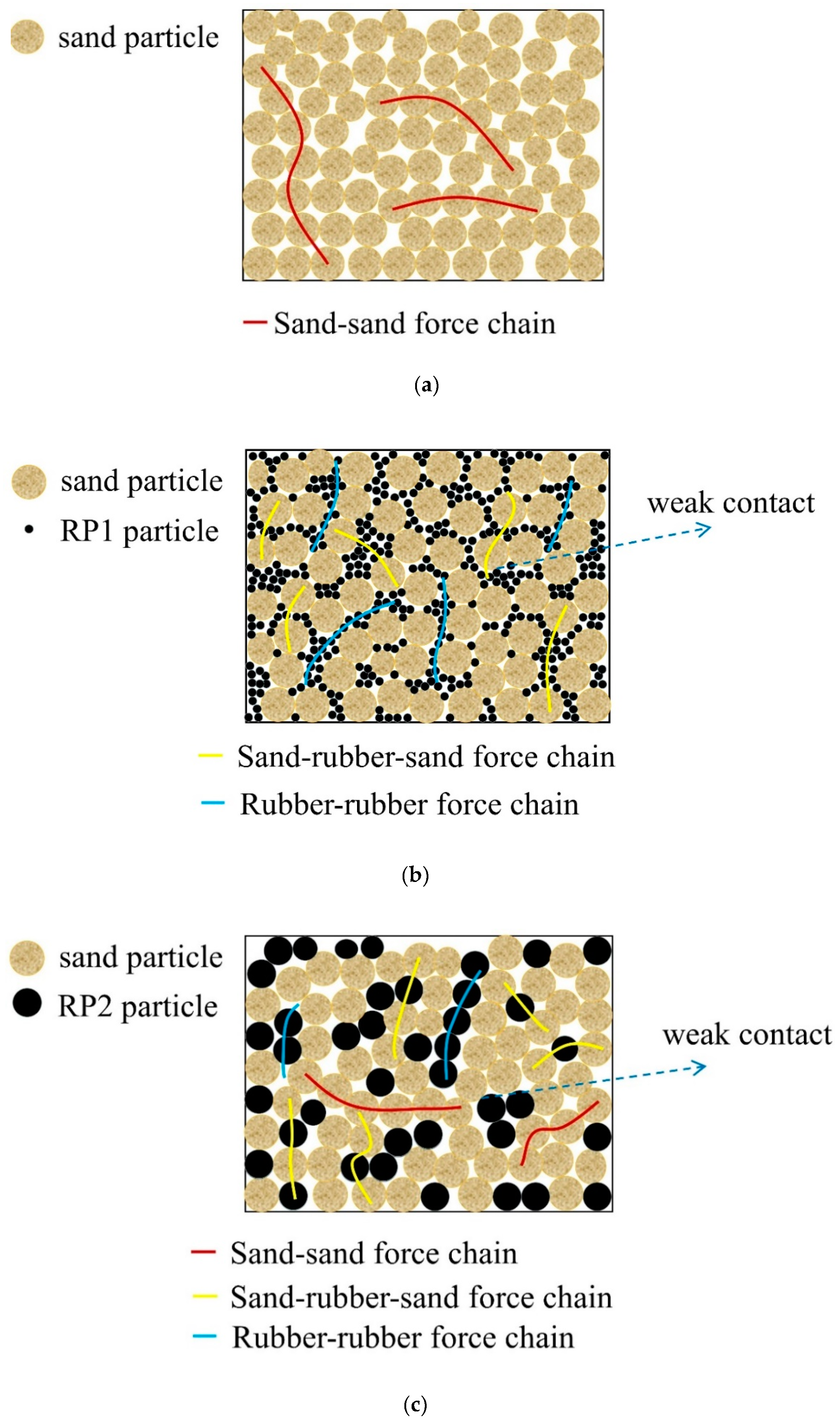



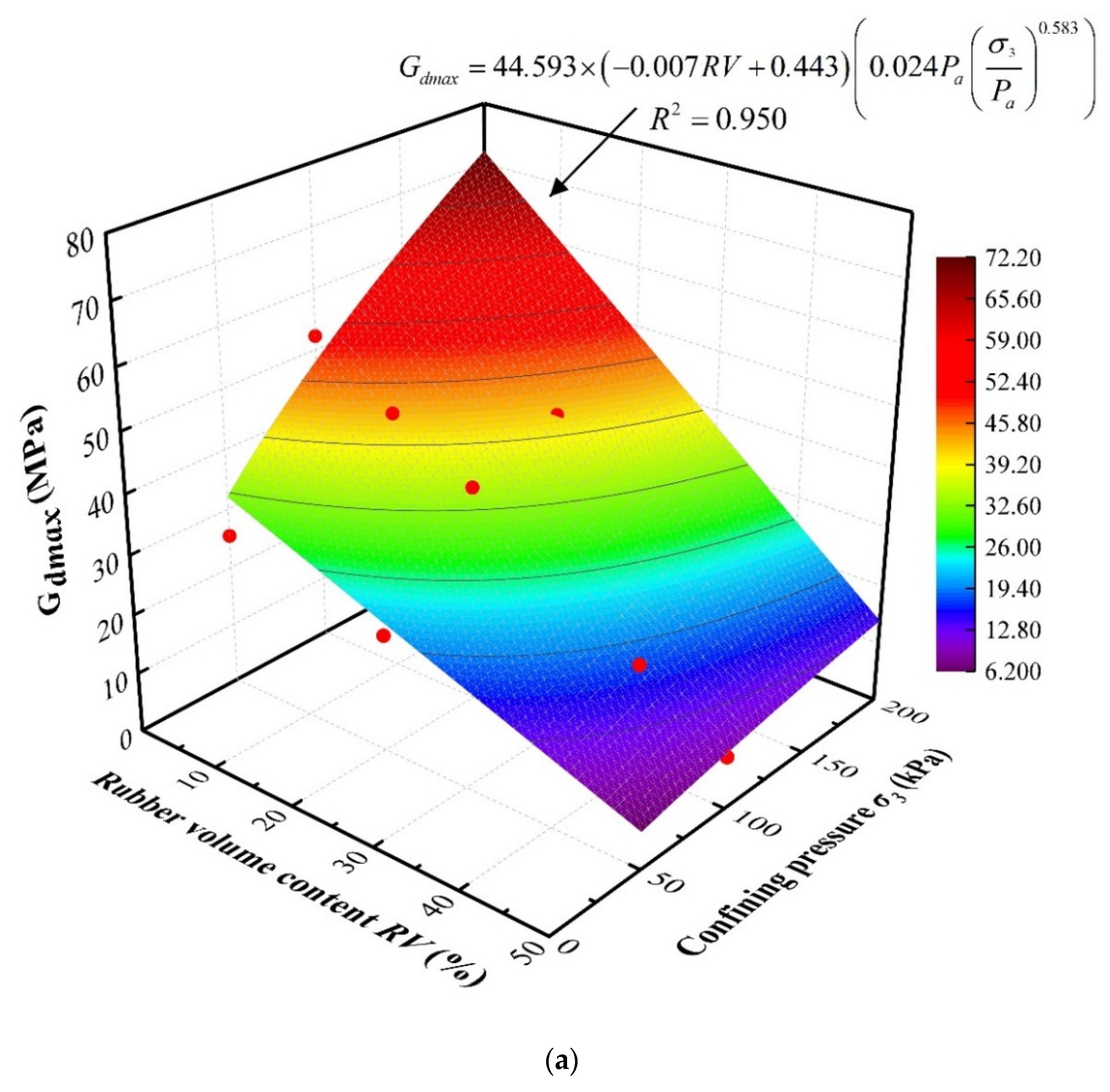
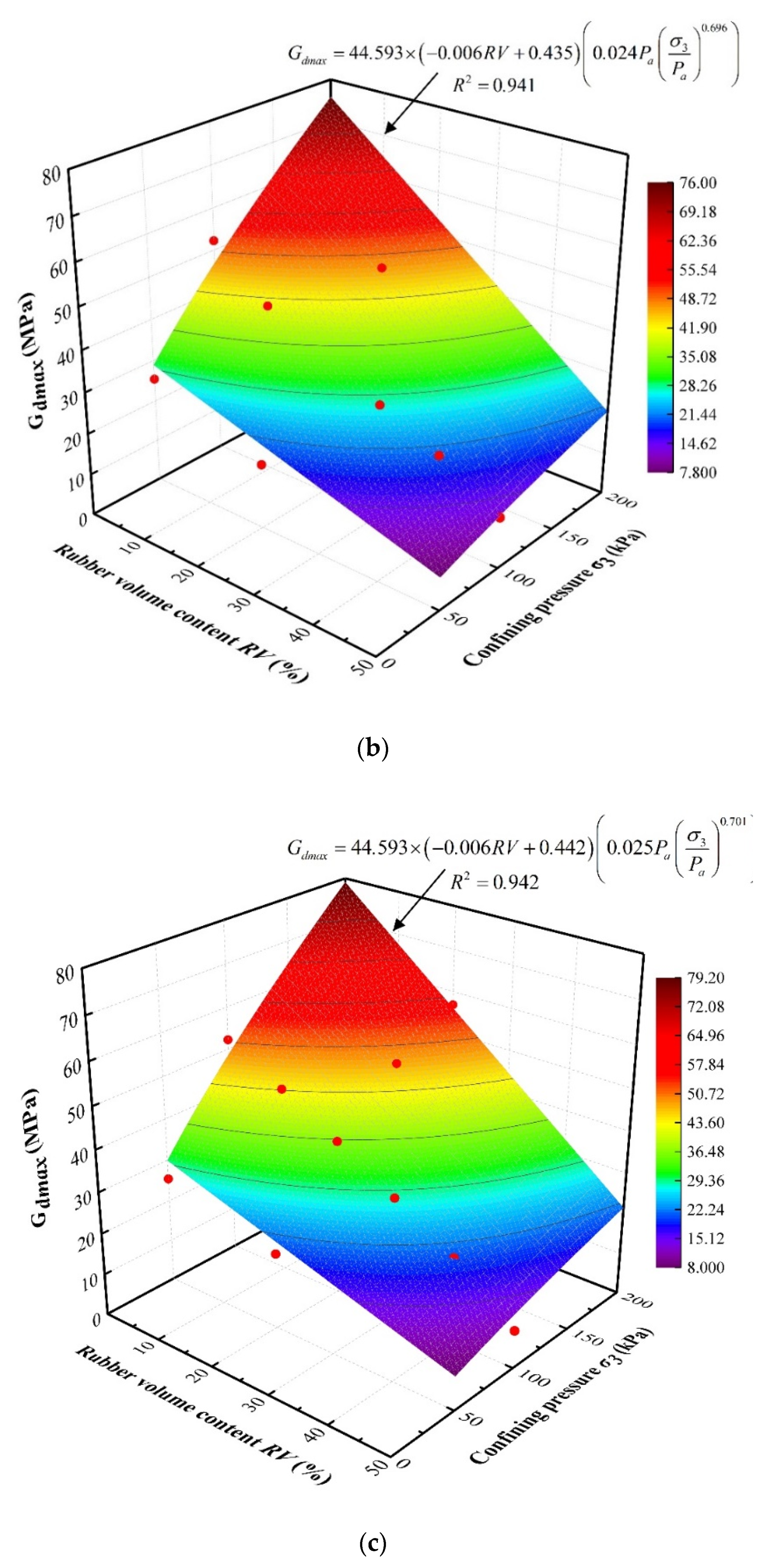
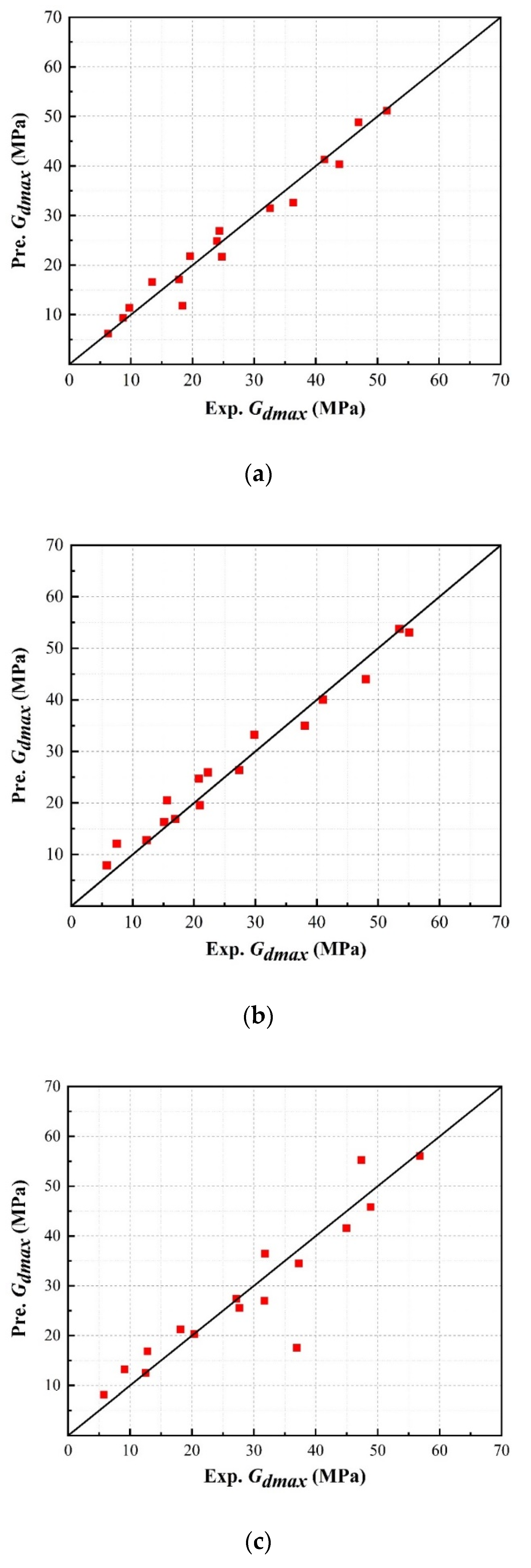
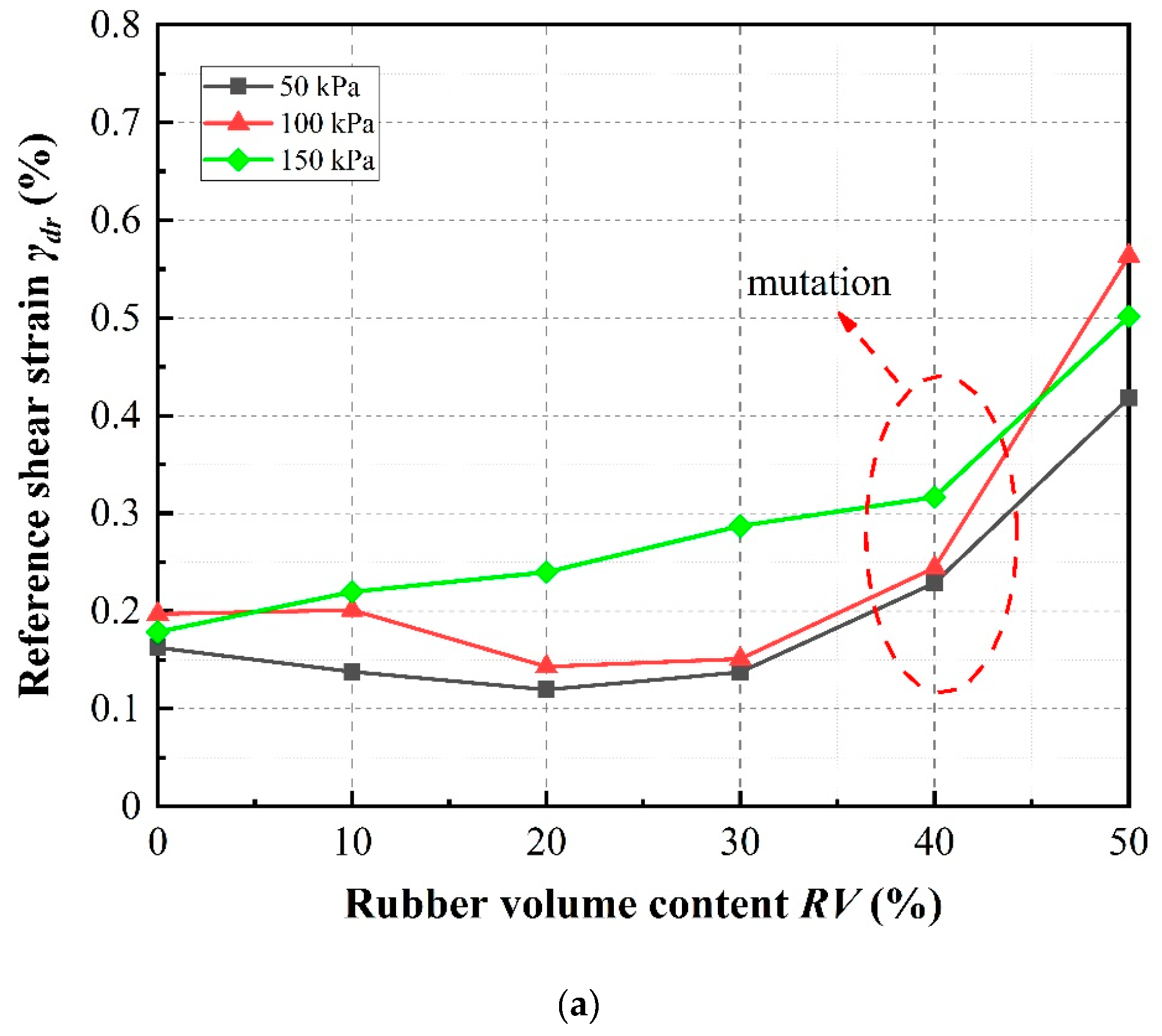

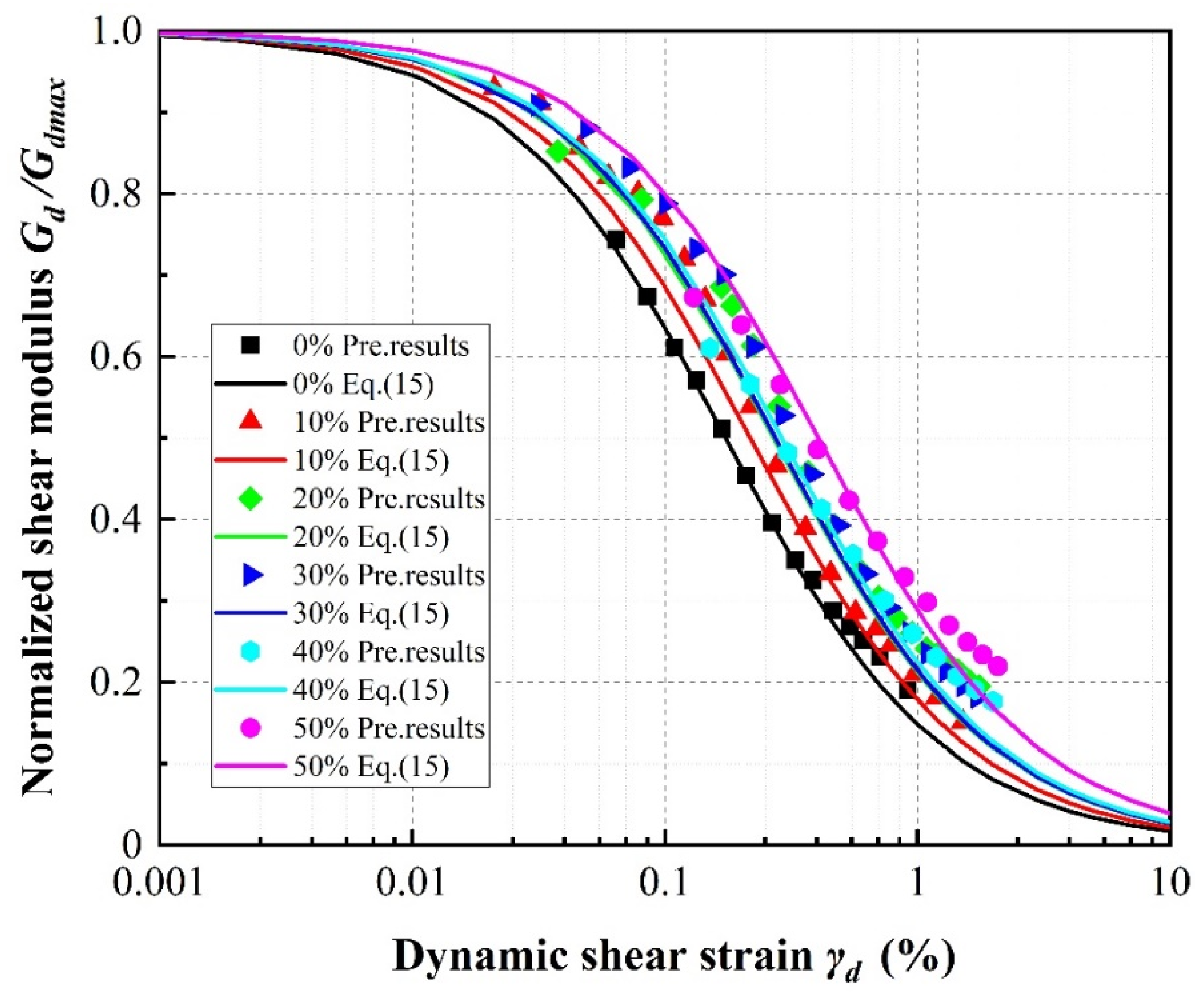
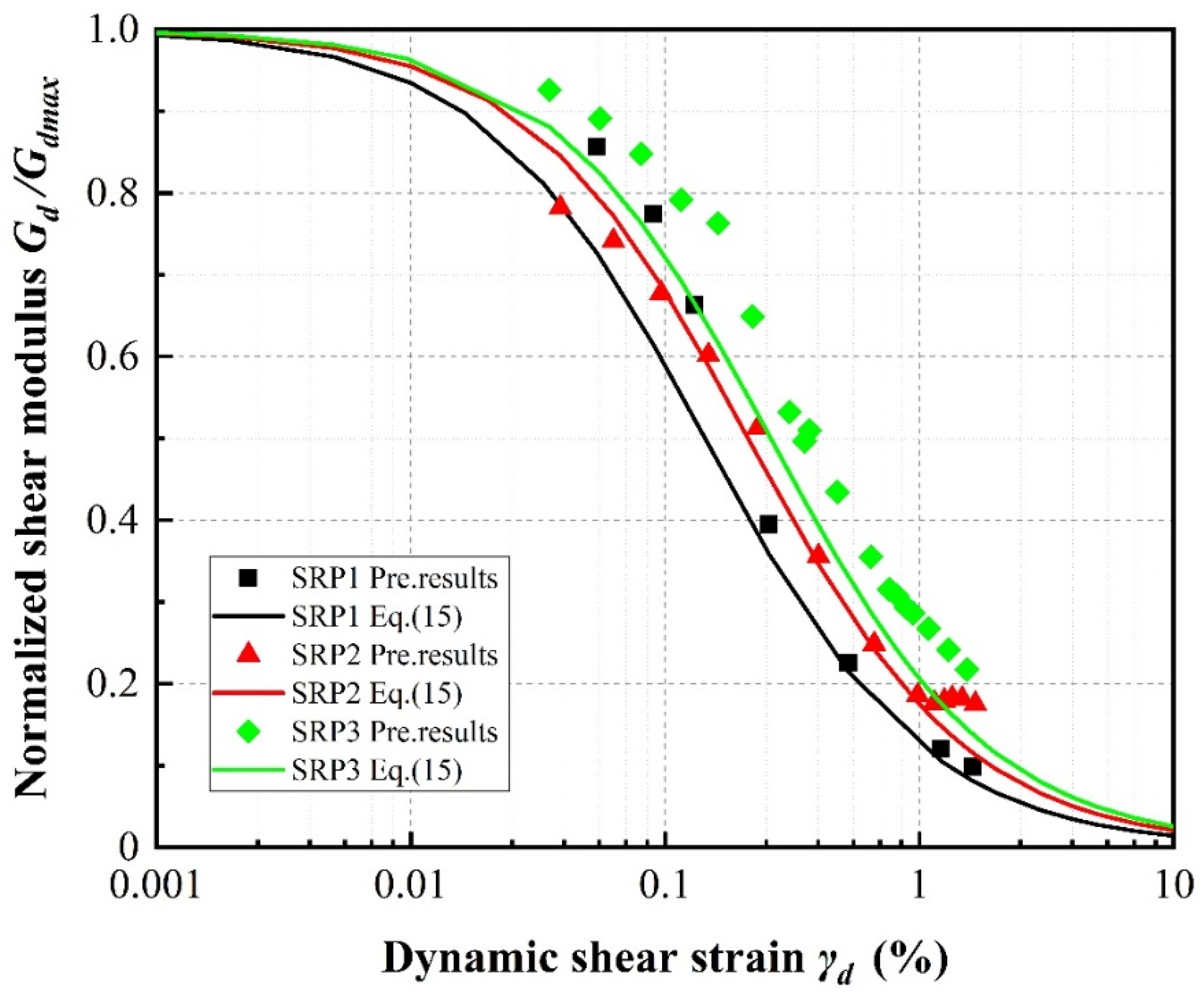
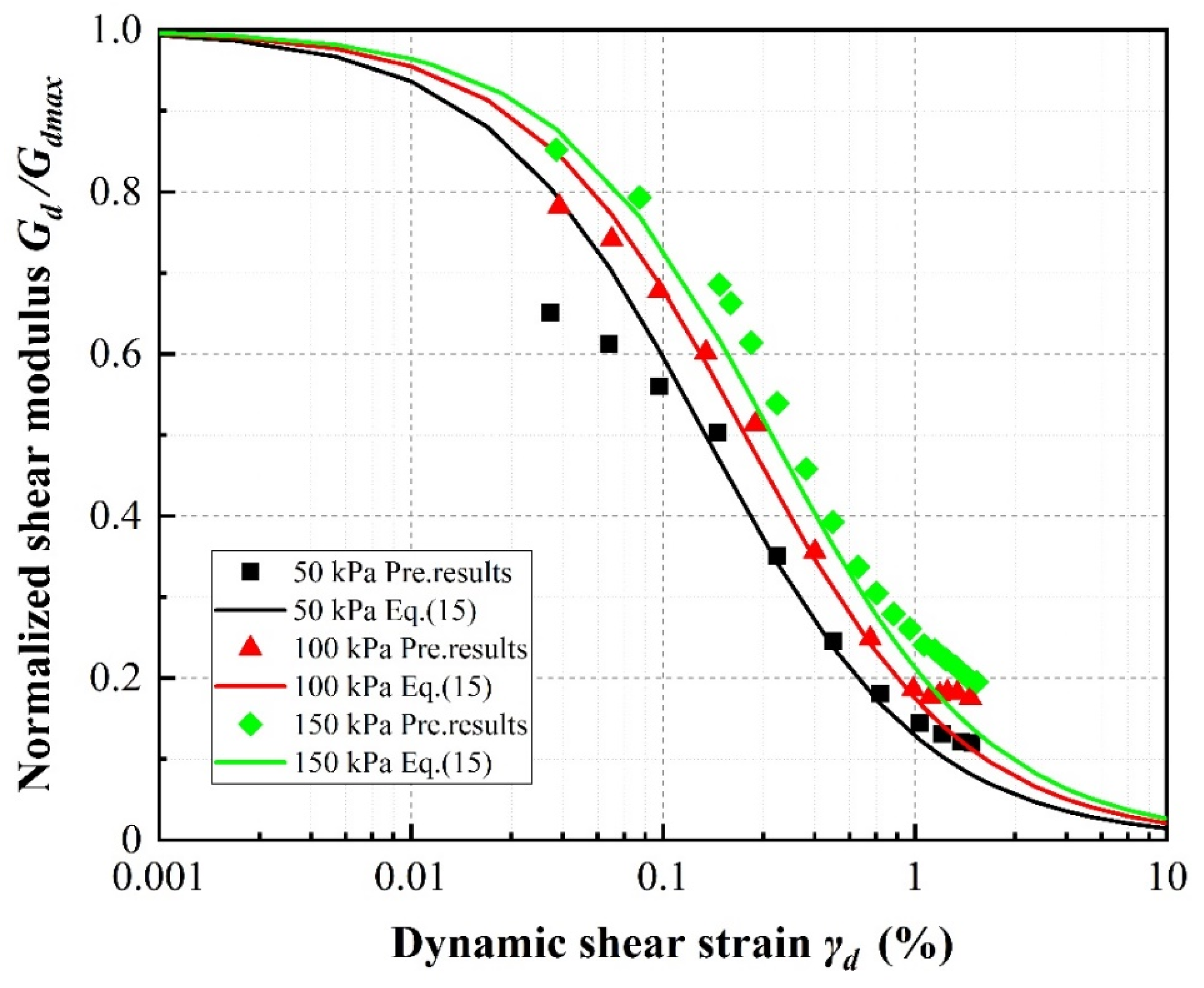
| Type | Minimum Grain Size Dmin (mm) | Maximum Grain Size Dmax (mm) | Mean Grain Size D50 (mm) | Size Ratio |
|---|---|---|---|---|
| Sand | 0.075 | 2 | 0.66 | 0 |
| RP1 | 0.05 | 0.1 | 0.075 | 0.11 |
| RP2 | 0.1 | 2 | 0.5 | 0.75 |
| RP3 | 2 | 4 | 3 | 4.54 |
| Type | Rubber Particle Size | Rubber Volume Content (%) | Size Ratio | Mean Effective Confining Pressure σ3 (kPa) | ρdmax (g/cm3) | ρdmin (g/cm3) | Dr | ρd (g/cm3) | Mixture Weight (g) |
|---|---|---|---|---|---|---|---|---|---|
| Pure Sand | - | 0 | 0 | 50, 100, 150 | 1.97 | 1.72 | 0.5 | 1.84 | 158.6 |
| SRP1 | RP1 | 10 | 0.11 | 50, 100, 150 | 1.86 | 1.55 | 0.5 | 1.69 | 145.7 |
| 20 | 50, 100, 150, 200 | 1.73 | 1.44 | 1.57 | 135.3 | ||||
| 30 | 50, 100, 150 | 1.61 | 1.31 | 1.44 | 124.1 | ||||
| 40 | 50, 100, 150 | 1.48 | 1.19 | 1.32 | 113.8 | ||||
| 50 | 50, 100, 150 | 1.29 | 1.07 | 1.19 | 102.6 | ||||
| SRP2 | RP2 | 10 | 0.75 | 50, 100, 150 | 1.78 | 1.49 | 0.5 | 1.62 | 139.6 |
| 20 | 50, 100, 150, 200 | 1.74 | 1.47 | 1.59 | 137.1 | ||||
| 30 | 50, 100, 150 | 1.67 | 1.31 | 1.47 | 126.7 | ||||
| 40 | 50, 100, 150 | 1.45 | 1.17 | 1.30 | 112.1 | ||||
| 50 | 50, 100, 150 | 1.33 | 1.07 | 1.19 | 102.6 | ||||
| SRP3 | RP3 | 10 | 4.54 | 50, 100, 150 | 1.91 | 1.69 | 0.5 | 1.78 | 153.4 |
| 20 | 50, 100, 150, 200 | 1.82 | 1.47 | 1.63 | 140.5 | ||||
| 30 | 50, 100, 150 | 1.75 | 1.43 | 1.57 | 135.3 | ||||
| 40 | 50, 100, 150 | 1.60 | 1.30 | 1.43 | 123.3 | ||||
| 50 | 50, 100, 150 | 1.47 | 1.17 | 1.30 | 112.0 |
© 2020 by the authors. Licensee MDPI, Basel, Switzerland. This article is an open access article distributed under the terms and conditions of the Creative Commons Attribution (CC BY) license (http://creativecommons.org/licenses/by/4.0/).
Share and Cite
Li, J.; Cui, J.; Shan, Y.; Li, Y.; Ju, B. Dynamic Shear Modulus and Damping Ratio of Sand–Rubber Mixtures under Large Strain Range. Materials 2020, 13, 4017. https://doi.org/10.3390/ma13184017
Li J, Cui J, Shan Y, Li Y, Ju B. Dynamic Shear Modulus and Damping Ratio of Sand–Rubber Mixtures under Large Strain Range. Materials. 2020; 13(18):4017. https://doi.org/10.3390/ma13184017
Chicago/Turabian StyleLi, Jianfeng, Jie Cui, Yi Shan, Yadong Li, and Bo Ju. 2020. "Dynamic Shear Modulus and Damping Ratio of Sand–Rubber Mixtures under Large Strain Range" Materials 13, no. 18: 4017. https://doi.org/10.3390/ma13184017
APA StyleLi, J., Cui, J., Shan, Y., Li, Y., & Ju, B. (2020). Dynamic Shear Modulus and Damping Ratio of Sand–Rubber Mixtures under Large Strain Range. Materials, 13(18), 4017. https://doi.org/10.3390/ma13184017





